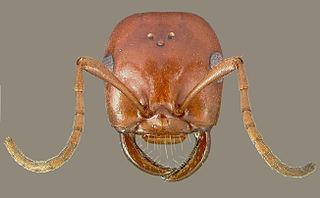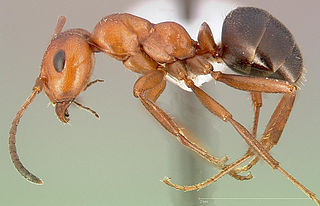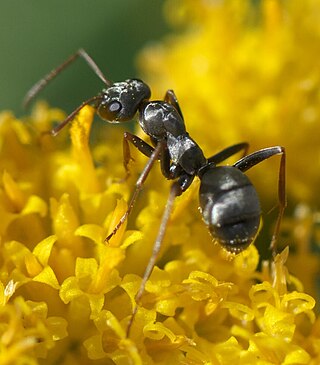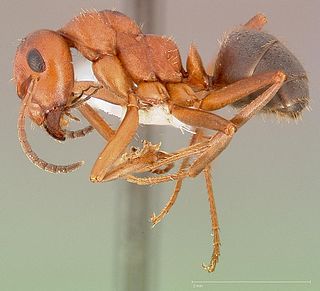
Formica is a genus of ants of the family Formicidae, including species commonly known as wood ants, mound ants, thatching ants, and field ants. Formica is the type genus of the Formicidae, and of the subfamily Formicinae. The type species of genus Formica is the European red wood ant Formica rufa. Ants of this genus tend to be between 4 and 8 mm long. Ants belonging to the Formica genus possess a single knob or bump located between their thorax and abdomen. These ants primarily feed on honeydew, a sugary liquid produced by aphids. Interestingly, Formica ants appear to take on a shepherding role with smaller aphids, relocating them to different parts of plants to ensure a continuous food source for the aphids. By doing so, the ants can establish a relatively sustainable honeydew supply for both themselves and their colony.

Polyergus is a small genus of ants with 14 described species. They are also referred to by the names "slave-raiding ants" and "Amazon ants". They are characterized by their habit of raiding nests for workers.

Polyergus breviceps is a species of ant endemic to the United States. It is a social parasite of other ants, namely of Formica gnava but also of Formica occulta and Formica argentea. Polyergus is an inquiline parasite, having lost its ability to take care of its young and themselves. "The workers do not forage for food, feed the young or the queen, or even clean up their own nest". To survive, Polyergus workers raid Formica nests to steal the pupae—which, once hatched, become workers of the mixed nest. This sort of relationship is not unique, of the approximately 8,800 species of ants, at least 200 have evolved some form of symbiotic relationship with one another. What makes Polyergus special is the way a newly mated queen can, all by herself, take over a Formica nest and start a new colony.

Formica incerta is a species of ant found in eastern North America. It is the most common species of Formica in many areas, and excavates underground nests with small entrance holes. Its diet includes nectar produced by extrafloral nectaries and honeydew, which it obtains from aphids and treehoppers. It is the main host for the slave-making ant Polyergus lucidus. F. incerta was first described by Italian entomologist Carlo Emery in 1893. Its specific name comes from the Latin incertus meaning "uncertain" and seems particularly apt given the subsequent uncertainty as to the validity of the species and the difficulty in distinguishing this ant from other species living in the same area.

Formica dakotensis is a species of ant in the family Formicidae.

Formica comata is a species of ant in the family Formicidae.

Formica perpilosa is a species of ant in the family Formicidae.

Formica propinqua is a species of ant in the family Formicidae.

Formica neorufibarbis is a species of ant in the family Formicidae.

Formica podzolica is a species of ant in the family Formicidae.

Formica oreas is a species of ant in the family Formicidae.

Formica integra is a species of ant in the family Formicidae.

Formica gagatoides is a species of ant in the family Formicidae. It is found in Europe.

Formica integroides, also known as the Vinegar Ant, is a species of ant in the family Formicidae.

Formica argentea is a species of ant in the family Formicidae.

Formica gnava is a species of ant in the family Formicidae.

Formica pergandei is a species of ant in the family Formicidae.
Geotrupes ulkei, or Ulke's earth boring beetle, is a species of earth-boring scarab beetle in the family Geotrupidae.

Formica densiventris is a species of ant in the family Formicidae.


















